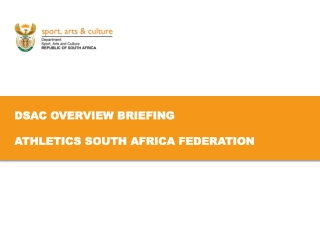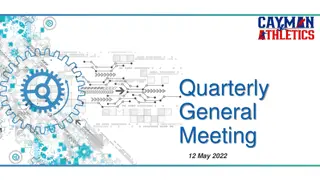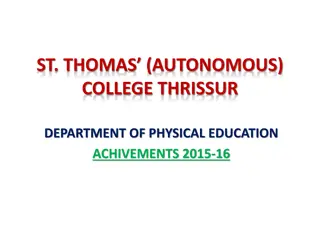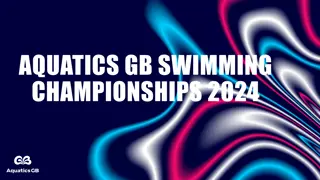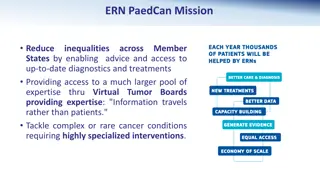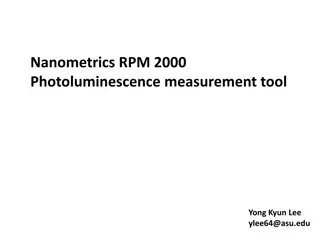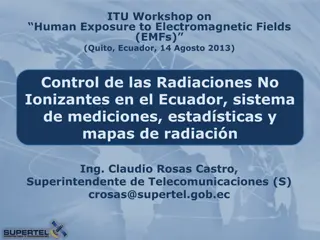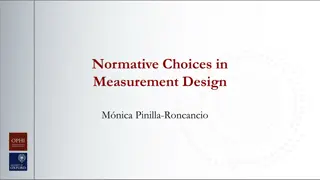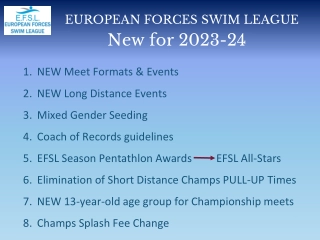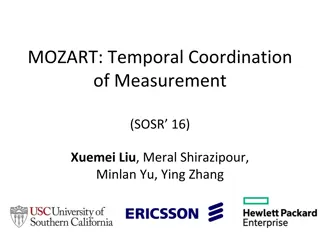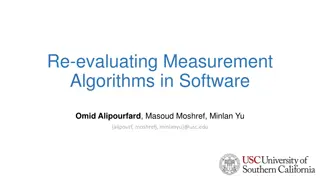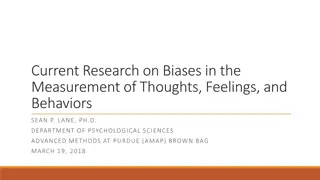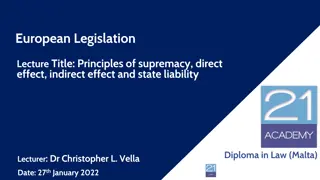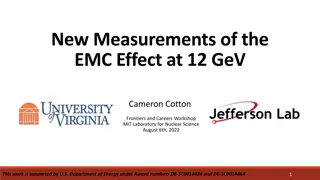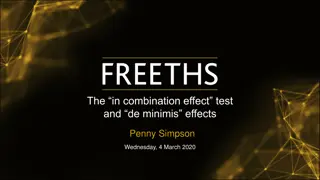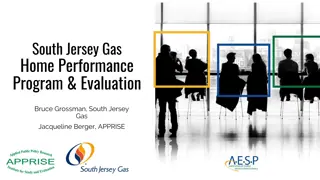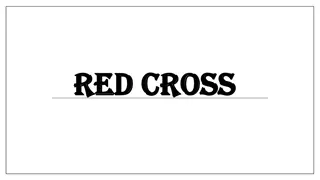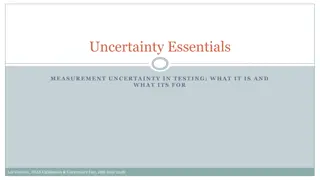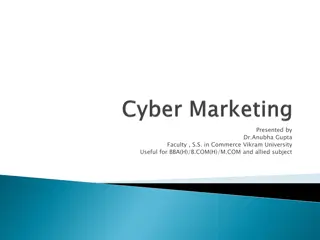Events as a Strategic Marketing Tool: Effect Measurement and Evaluation - World Cyclo-Cross Championships 2009
This publication discusses the importance of measuring and evaluating the impact of events, focusing on the economic impact study of the World Cyclo-Cross Championships 2009 in Hoogerheide, The Netherlands. It highlights the unique nature of event evaluation, providing insight into the methodology and key findings of the study commissioned by the municipality of Woensdrecht. The report emphasizes the need for effective measurement models tailored to specific events, showcasing the role of events as strategic marketing tools.
Download Presentation

Please find below an Image/Link to download the presentation.
The content on the website is provided AS IS for your information and personal use only. It may not be sold, licensed, or shared on other websites without obtaining consent from the author. Download presentation by click this link. If you encounter any issues during the download, it is possible that the publisher has removed the file from their server.
E N D
Presentation Transcript
COMPLIMENTARY TEACHING MATERIALS Events as a Strategic Marketing Tool 2nd Edition Doroth Gerritsen and Ronald van Olderen
Appendices to Chapter 10 COMPLIMENTARY TEACHING MATERIALS
Effect Measurement and Evaluation There is not yet an extensive body of literature on the effect measurement and evaluation of events. Most practitioners/people involved in day-to-day practice increasingly appreciate the importance of measurements, and this is something that cannot be separated from the formulation of proper objectives. There is no ready-made model of effect measurement and evaluation, as we have already pointed out in this chapter. Each event is unique, and therefore it is necessary to construct a made-to measure evaluation model on each occasion. Existing methods can then be a source of inspiration. That is why we describe cases and examples of models for effect measurement and evaluation in these appendices on the website. Appendix 1: Economic-impactstudy World Cyclo-Cross Championships 2009 Hoogerheide A Study of the Economic Impact of the World Cyclo-Cross Championships in Hoogerheide, The Netherlands, in 2009 The W nsch Model: Return on Communication Economic Impact Study European Swimming Championships, Eindhoven 2008 A Study of the Economic Impact of the European Swimming Championships in the City of Eindhoven, The Netherlands Amstel Gold Race 2008 A Study of the Host Community s Perception of the Effects of Large-Scale Sports Events Appendix 2: Appendix 3: Appendix 4: COMPLIMENTARY TEACHING MATERIALS
Appendix 1 Economic Impact Study World Cyclo-Cross Championships 2009 KEY FACTS Type of event: 2-day international outdoor sports event. Study commisioned by: municipality of Woensdrecht, the Netherlands. IN GENERAL Various cycle races and world championships are organized under the aegis of the UCI the Union Cycliste Internationale, or the International Cycling Association. Thus, it happened that Hoogerheide, which is a part of the municipality of Woensdrecht, was awarded the organization of the World Championships Cyclo-Cross in 2009. The championship races on 31 January and 1 February 2009 were organized by the Grote Prijs Adrie van der Poel Foundation in collaboration with the KNWU, the Dutch cycling association. On Saturday, 31 January, the championships for juniors and promising cyclists took place, and on Sunday, 1 February, it was the turn of the ladies, the top cyclists and young talented cyclists. COMPLIMENTARY TEACHING MATERIALS
WHO WANTS TO KNOW WHAT, AND WHY? The Grote Prijs Adrie van der Poel course has featured in the programme of the UCI World Cup Cyclo-Cross for years, and the cyclo-cross is one of the prominent events in the municipality of Woensdrecht. Prior to being awarded the organization of the championships, the municipal organizational costs and granted a permit for this event after the approval of the municipal council. It matters very much for the authorities to be able, afterwards, to render account for the policy pursued and to show the tangible results of this 2-day event. Has Woensdrecht been put on the map? It is also thought that the findings can be an inspiration for future policy. In addition to an impact study, a study was conducted among residents and entrepreneurs to find out about their experiences. The outcomes have been described in an evaluation report. The key questions were almost identical to those asked with regard to the European Swimming Championships: How much does the World Championship Cyclo-Cross contribute to the region in financial terms? What are the differences in spending between people from inside and outside the COROP area of Zuidwest-Brabant? What part of the spending is additional? authorities underwrote part of the COMPLIMENTARY TEACHING MATERIALS
COROP AREA AND INPUTOUTPUT MODEL The target group of this study comprised all visitors to the World Championships Cyclo- Cross, with the exception of VIPs, cyclists and accredited persons. So, there is a difference compared to the target group of the European Swimming Championships where, in contrast, the participants were part of the research population. The COROP area is delineated by the postal codes of 4600 to 4799, and the results of the surveys were used as input for the input output model for this region. RESEARCH METHOD Desk research and interviews with the organization and the city officials of Woensdrecht provided an insight into the various items of the budget. On both days, visitors were surveyed on leaving the track at four different exits. Every fifth person leaving was surveyed. On Saturday, 131 surveys were conducted, and 249 on Sunday. On the basis of the estimated number of visitors (48,900), a figure obtained during an interview with the Communication Department of the city, and the size of the sample, 380 valid surveys, it can be stated with a certainty of 95% that the results could have been 5% higher or lower. The survey questions were almost identical to those asked in the study of the European Swimming Championships, based on Likert scales and response categories. COMPLIMENTARY TEACHING MATERIALS
CONCLUSIONS ON ECONOMIC IMPACT Of those surveyed, 65% came from outside the COROP area. Within this group, 85% visited the region primarily because of the event; this meant that 85% of the visitors spent additional money. Research shows that spending on travel (in and around Zuidwest-Brabant) and food and drinks was substantially higher than during the European Swimming Championships. The figures for additional spending are presented in Table 10.5, subdivided into types of spending. Total additional spending has been calculated by linking the total number of visitors of 48,900 and average spending. The additional spending of approximately 2.8 million is regarded as input in the input output model. The results can be found in Table 10.6. The potential production in the region as a result of the event was approximately 3.3 million. The conclusions were: As a result of the event, an additionalamount of more than 2.8 million was spent in the region. In comparison to the European Swimming Championships, there were more visitors. These visitors spent their money differently: on food, drinks and overnight stays in the region. Mind you, this concerned a 2-day outdoor event. The event had a positive effect on the image of the region, as well as international interest in and recognition of the region. This became clear from an experience study that was done at the same time. COMPLIMENTARY TEACHING MATERIALS
Table 10.5.Additional spending. Average ( ) Spending ( ) 1. Overnight stays 53.51 917,856 2. Food and drink 28.66 907,223 3. Merchandising 4.19 132,544 4. Travel (in and around north-west Brabant) 11.86 375,436 Subtotal 2,333,059 Of which 85% additional 1,983,100 5. Organization 850,500 Additional spending 2,833,600 COMPLIMENTARY TEACHING MATERIALS
Table 10.6.Inputoutput model. Input per business sector ( ) Output per business sector ( ) 1. Agriculture, forestry, fishery 0.00 20,354.00 2. Mineral extraction 0.00 6,673.00 3. Industry, energy and water companies 0.00 42,360.00 4. Construction 0.00 8,093.00 5. Commerce 102,609.0 138,552.00 0 6. Catering 1,533,023 1,769,820.00 .00 7. Transport, storage and communication 308,968.0 334,944.00 0 8. Financial institutions 39,000.00 55,460.00 9. Lettings, business services 850,000.0 891,149.00 0 10. Government, defence, social services and sub-education 23,463.00 11. Health and welfare 0.00 24,489.00 12. Environmental services, culture, services 0.00 9,073.00 13. Imports 0.00 0.00 Total 2,833,600 3,324,430.00 .00 COMPLIMENTARY TEACHING MATERIALS
A CRITICAL NOTE It is very hard to be complete in a study of the impact of an event. There are always external factors that can hardly be controlled. Companies or sponsors, for example, can develop activities in the context of the World Championships Cyclo-Cross of which the organization or researcher has no knowledge. As a consequence, the related expenditure is not included in the input output model. Exit polls were conducted with each fifth person leaving the event. But, not every visitor was willing or able to cooperate, so sometimes it was the sixth or seventh person leaving who was surveyed, which was a risk with regard to the reliability of the research. Another matter is that it is always hard to pin down exactly what is the additional spending. With respect to this study, a conscious choice was made for the COROP area and the substitution effect. Finally, the calculations are based on estimates of the number of visitors to the event. These numbers are obtained from external parties; the exact number is not known. The fact is that, at the moment, there is no uniform measuring tool to measure visitor numbers at public events, although there are those who claim that exact measurement is possible. (Source: van Schendel, 2009a, adapted by the authors.) COMPLIMENTARY TEACHING MATERIALS
Appendix 2 The W nsch Model: Return on Communication BACKGROUND OF THE MODEL This model has ensued from the increasing importance of experience, and thus events as well, and it has the world-famous idea of The Experience Economy of Pine and Gilmore (1999) as its starting point. W nsch (2008) finds that events generally generate many intangible effects. In spite of this, he went in search of a model to make those effects measurable and tangible. This gave rise to several questions: how can events be classified exactly? How can they be made mutually comparable? What can be learned from other events? But also: how should events be evaluated? What exactly should be evaluated? What is the intention? Are there any existing models? What models should be developed? Is it hard data that are required, such as number of visitors, sales and turnover figures, or soft data, such as image, reputation and recognition? In general, management is interested in return on investment (ROI): the board, client or organizer wants to know what are the concrete returns of the investments in an event; something that is always hard to find out in the case of events. This is also a major concern in marketing communication and advertising; expenditure is studied critically and weighed, including the expenditure on events. Return on communication is based on return on objectives (ROO) and has been developed in the domain of process and project management. The basic idea is that if the objectives at the start of the project, or event, are clear and quantifiable, interim adjustments can be made, and that on the conclusion of the project there will be a clear picture of the costs and results. FOCUS OF THE MODEL Various perspectives with respect to the organization of events can also be seen in this model. The focus of the W nsch model is on the communication objectives. These should be clear and measurable. The model can be used to show clients and financiers what the ROI will be. COMPLIMENTARY TEACHING MATERIALS
AN EXPLANATION OF THE MODEL The starting point of this model is the assumption that an event is a mode of communication. An event should be communication media like TV and radio and interpersonal or face-to-face communication. An event is really a special form of group communication. It is a platform that is suitable for one-on-one communication, but it can also reach out to bigger groups. It can be a social network of close or less close relationships. What such a social network should generate during and after an event is called the return on communication (ROC). An assessment of the result of that communication can then be made on condition that clear communication objectives are coupled to an event; this makes the ROC the chief determinant of the success of an event. Three perspectives are involved in the ROC (see Fig. 10.8). We will explain Fig. 10.8 on the basis of the Festival Mundial. Mundial Productions BV is the organizer who tries to organize this festival in Tilburg (the Netherlands) as efficiently as possible and within budget. The various stakeholders, such as the city of Tilburg and several firms, are concerned with idealistic objectives, for instance, fostering tolerance in a multicultural society. Naturally, this objective is shared by the organizer himself. The visitor will have a positive experience due to the programming and the unique set-up of the programme. positioned somewhere between mass COMPLIMENTARY TEACHING MATERIALS
Three perspectives of return of communication (source: Wnsch, 2008). COMPLIMENTARY TEACHING MATERIALS
The ROC comprises: the return on objectives (ROO = the extent to which goals have been achieved) the individual return on event (ROE = the degree to which individuals have been influenced) the return on investment (ROI = the extent to which resources have been used efficiently). The corresponding formula is as follows: In the formula, z stands for the value assigned by stakeholders (government, public, guests, management, citizens, employees) to a specific event. The plus sign can also be replaced by a multiplication sign to assign a value to the dependence of the individual factors. The ROC is determined by various perspectives, as shown below: ROC = involvement, satisfaction total perspective ROE = experience/intensity (density) participant in event ROO = effectiveness/reach stakeholder ROI = efficiency/usefulness client At the start of each event, it should be decided from which perspective the ROC will be considered. In other words: if it is the intention to measure whether an event has been organized efficiently on the basis of predetermined objectives and resources, the focus should be on the perspective of the sponsor of the event (ROI). If an answer is required to the question whether an event has been effective and what reach it has had, measurements should be made on the basis of the goals of the relevant stakeholders (ROO). If the primary question is in what degree a visitor to an event has really been affected, the perspective of the participant (ROE) is the correct choice. The total effect of an event as a communication tool can be learned by measuring satisfaction and involvement, taking all three perspectives into consideration (ROC). A CRITICAL NOTE The W nsch model has not been fully developed and not a lot of experience has been gained with it in practice. The range of ideas is interesting, but requires further development. The model is less suitable to the evaluation of events that have objectives other than communication objectives. (Source: W nsch, 2008, adapted by the authors.) COMPLIMENTARY TEACHING MATERIALS
Appendix 3 Economic Impact Study European Swimming Championships, Eindhoven 2008 KEY FACTS Type of event: 11-day international indoor sports event. Study commissioned by: City of Eindhoven. IN GENERAL The European Swimming Championships 2008 was held from Thursday, 13 March until Monday, 24 March at the Tongelreep National Swimming Centre in Eindhoven (the Netherlands). The European Swimming Championships is a very large biannual international sports event that each time is organized in a different European city, and only once before in the Netherlands: that honour went to Utrecht in 1966. During the 29th championships, the programme comprised of three swimming disciplines: swimming (long distance; 50-m pool), synchronized swimming and diving. As many as 878 swimmers from 42 different countries participated in the event, which was attended by more than 31,480 people. Approximately another 130 million people all over the world watched the event on television, altogether about 400 h of TV coverage. In addition to contesting for gold, silver and bronze medals at the 2008 European Championships, many competitors used the meeting to earn starting permits for the 2008 Olympic Games, which made the event all the more interesting for the spectators. Besides, quite a number of side events were organized around the championships to involve the old and the young actively in the event. For instance, the EKNZBhouse was set up, where thematic discussions and congresses were held for members of the swimming association, and training sessions for young competitors were organized, focused on the disciplines of swimming, synchronized swimming and diving. During the European Championships Swimming Festival, children from groups 7 and 8 of Eindhoven s primary schools were introduced to the sport of swimming, and a mini championship was organized for student swimmers. And finally, the entire city was festooned with banners and posters, in keeping with the atmosphere of the event. COMPLIMENTARY TEACHING MATERIALS
WHO WANTS TO KNOW WHAT, AND WHY? The European Swimming Championships were a very important event for Eindhoven in the context of Sports 2008. For that reason, the Sports Committee of the Department of Social Development of the city of Eindhoven wanted an elaborate evaluation of the event on the basis of questions like: how will Eindhoven be put on the map from both a national and international perspective, and what will be the impact on the city s image? What is the economic impact of this event on the city? How have those who live near the venue of this event experienced it? So, quite a few questions, which were submitted to various parties in the form of three studies. The results of these studies have been described in an extensive evaluation report (van Schendel, 2008) that can be used by the city authorities to account for the policy pursued to win the nomination of the city of Eindhoven for this big event. Here, we focus on the economic impact of the event on the city of Eindhoven. Relevant questions in this context are: How much money was spent on various aspects of the European Swimming Championships? What are the differences in spending when comparing those within the COROP area of Zuidoost-Brabant, those outside that area and those abroad? A COROP area is part of a regional division of the Netherlands for the purposes of statistical analysis. There are 40 COROP areas. What part of the money spent is additional, and what is the economic impact of those sums? CONTRACTOR The NHTV International University of Applied Sciences has many years of experience in the field of research into (sports) events and is often asked to undertake an economic impact study for organizers, sponsors and government. As a result of the identical systematic working method, it is possible to compare various studies with each other. COMPLIMENTARY TEACHING MATERIALS
COROP AREA AND INPUTOUTPUT MODEL The subjects of research of the event are the visitors, the athletes and their coaches, the press and the organization. It is specifically their spending behaviour that is the subject of study. For the purposes of this research, use is made of the input output model that applies to the COROP area that includes Eindhoven: Zuidoost-Brabant in this case. The Central Office of Statistics has data of the input output model, specified for each COROP area. The model consists of a system of multipliers that indicate to what extent the national income changes when autonomous spending changes. It also describes the economic structure of a region. On the basis of the defined input (spending), the model calculates the output. This output is the potential economic production in the area as a result of the event. In other words: if the event had not taken place, there would have been no production. Ultimately, the economic impact applies to the additional amount of spending. In the context of this study, additional means that only those respondents from outside the COROP area are included in the calculations of who would not have come to Eindhoven if the European Swimming Championships had not been held there. This means that the spendings of the inhabitants of the region, the percentage of visitors who would still have been in Eindhoven if the event had not taken place (substitution effect) and the subsidy from the government are not regarded as additional spending. These spendings would have been realized in the region anyway (see Fig. 10.9). RESEARCH METHOD First, on the basis of interviews with the organization concerned, the average expenditure and the numbers of participating teams, companies and reporters have been established. Subsequently, quantitative research was conducted through exit polls among the event visitors. Every fifth visitor leaving was surveyed, spread across several days of the event. Sold-out races were calculated in and more polls were conducted during the last few days than at the start. COMPLIMENTARY TEACHING MATERIALS
Additional spending (source: van Schendel, 2008). On the basis of the number of visitors (31,480) and the size of the sample (389), the findings, with 95% certainty and a confidence interval of 5%, are generally binding. This means that the findings can be 5% higher or lower, with a certainty of 95%. The questions for this study are based on the objective of the client and on the required input for the model: visitor profile plus residing inside or outside the COROP area, spending profile (number of overnight stays, travel within the area, food and drink, merchandise), while allowing for the substitution effect. The substitution effect indicates whether a person from outside the COROP area would have been present if the event had not taken place. COMPLIMENTARY TEACHING MATERIALS
CONCLUSIONS ON ECONOMIC IMPACT Of the people surveyed who came from outside the COROP area (57.6% of the total), 89.2% would not have come to the region if the European Swimming Championships had not taken place. So, this concerns additional spending (see Table 10.3). This means that the participants, the press and the organization are largely responsible for the additional spending on this event. From the study, it is clear that visitors from the Netherlands rarely booked a hotel and, as a result, spent little on overnight stays. Spending on food, drink, merchandising and travel (in and around Eindhoven) was not very high. Average spending per person was linked to the number of visitors (31,480), the number of participants/coaches (1298) and the number of reporters (400), and subdivided on the Average ( ) Spending ( ) basis of the type of expenditure. 1. Overnight stays 75.54 3,241,560 2. Food and drink 12.70 504,063 3. Merchandising 4.73 163,775 4. Travel (in and around Eindhoven) Subtotal 3.61 72,603 3,982,001 Table 10.3. Additional spending. Of which 89.2% additional 5. Organization 3,551,943 2,940,000 Additional spending 6,491.943 COMPLIMENTARY TEACHING MATERIALS
The additional spending of 6,491,943 was then worked out in the inputoutput model. As a result of money circulating in a particular business sector, production in other sectors is increased. If the catering industry achieves a big turnover, for instance, there is work for the suppliers of meat, fish, vegetables and fruit as well. These mutual economic relationships are incorporated in the input output model (Table 10.4). The expenditure of the various target groups has subsequently been divided over the various business sectors and this completes the model. The potential production as a result of the sports event was 7,469,948.76, as can be seen in Table 10.4. The conclusions were: the event generated a considerable economic boost it was the press, the participants and the organization that were mainly responsible for the economic input the event caused little trouble because it did not take place in the city centre and lasted only 11 days. COMPLIMENTARY TEACHING MATERIALS
A CRITICAL NOTE It is very hard to be complete in a study of the impact of an event. There are always external factors that can hardly be controlled. Companies or sponsors, for example, can develop activities in the context of the European Swimming Championships of which the organization or researcher has no knowledge. As a consequence, the related expenditure is not included in the input output model. In this case, exit polls were conducted with each fifth person leaving the event. But, not every visitor was willing or able to cooperate, so sometimes it was the sixth or seventh person leaving, which was a risk with regard to the reliability of the research. Finally, it is always hard to pin down additional spending. With respect to this study, a conscious choice has been made for the COROP area and the substitution effect. (Source: de Kort and van Schendel, 2008, adapted by the authors.) COMPLIMENTARY TEACHING MATERIALS
Appendix 4 Amstel Gold Race 2008 A STUDY OF THE HOST COMMUNITY S PERCEPTION OF THE EFFECTS OF LARGE-SCALE SPORTS EVENTS KEY FACTS Type of event: 2-day cycling event. Reasearch commissioned by: the Amstel Gold Race organization. AMSTEL GOLD RACE The Amstel Gold Race is the biggest cycling event of the Netherlands and it has been an annual event held in the vicinity of Valkenburg since 1966. The past few years, this cycling event has comprised of two different races in one weekend: The official UCI Pro Tour Classic Amstel Gold Race with professional racers. The 43rd Amstel Gold Race took place on Sunday, 20 April 2008. The non-professional version of this cycling classic, in which amateurs and recreational cyclists can participate. The 7th rally of this particular race took place on Saturday, 19 April 2008. The Amstel Gold Race is the pride of Dutch cycling. The event features on the UCI Pro Tour calendar and the professional cyclists who participate can earn points for the UCI Pro Tour rankings, which used to be the World Cup rankings. In the history of this event, the winners have included many international top cyclists, among them Eddy Merckx and Bernard Hinault, multiple winners of the Tour de France, but also prominent Dutch cyclists such as Jan Raas, Michael Boogerd and Erik Dekker. A warm and friendly atmosphere is created in pubs and restaurants in the various cities along the course. The non-professional version of the Amstel Gold Race is completed the day before the official race and follows the same course as the professionals. This event draws a maximum of 10,000 racers to the south of Limburg each year. There are four different courses of 50, 100, 150 and 200 km, respectively. The participants will have the opportunity to climb famous hills such as Keutenberg, Gulpenerberg and, of course, Cauberg, just as the professionals will do the next day. Once they have finished their race on Cauberg, they will be welcomed as true heroes by friends and family who have come to Valkenburg for this special occasion. A considerable number of participants then stay on in the area for another day with their friends and family to watch the professionals race. COMPLIMENTARY TEACHING MATERIALS
WHO WANTS TO KNOW WHAT, AND WHY? The organizer of the Amstel Gold Race wanted to carry out research among the local population and other parties in the region to find out how the inhabitants and businesses had experienced the event. The organizer wants information about the commitment of the inhabitants of the region the race course passes through and about the extent of their commitment. The province grants the permit and needs the input from various cities and villages affected by the Amstel Gold Race in the south of Limburg, because the course passes through several of them. The organizer wants to prevent the cities and villages from lodging objections to the race. The organizer does not receive any subsidy from the government. The organizer wants to have a good idea of the population s support for the event. The organizer wants to measure public opinion and present the results to the various interested parties. The findings of the study can be found in an extensive evaluation report (Willemsen, 2008, and van Schendel, 2009a, edited by the authors) and can be used by the organizer to back up new applications for permits and discussions with sponsors. COMPLIMENTARY TEACHING MATERIALS
FOCUS OF THE STUDY: A PERCEPTION STUDY The leading question was how the host community had experienced the event and which effects were felt. In this context, the host community was defined as: The inhabitants and entrepreneurs of a city, or cities, where a large-scale event, sports or otherwise, takes place, and where the tangible effects can be felt. In this case, it affects the municipalities of Beek, Eijsden, Gulpen-Wittem, Nuth, Maastricht, Margraten, Meerssen, Simpelveld, Stein, Vaals, Valkenburg on the Geul and Voerendaal. (Willemsen, 2008, and van Schendel, 2009a, adapted by the authors) Besides the economic effects, there are other effects of events that can be of great value: for example, promotional and social effects. These effects are much less tangible and depend largely on personal experiences, or perception. National and/or regional governments apparently find it hard to make good decisions purely on the basis of economic effects where it concerns the granting a permit for an event, or whether or not it should be subsidized, because those economic effects are not always convincing in practice. The host community plays a vital part in the exploitation of events, something to which a city marketing policy rarely pays sufficient attention. Sometimes, residents and companies feel hardly any involvement in the development and profiling of a city or region, which may incur the risk of a string of legal objections that can delay an event taking place. When there is little or no involvement, it is more likely that residents and companies experience an event as a nuisance. Yet, the moment when the host community feels involved in an event, it can have a very positive impact on the image of a city or region. In that case, the effects of an event are experienced as positive ones and, as a consequence, it meets with approval. The perception study was intended to provide answers to the following questions: Which effects are perceived by the host community? How are these effects experienced? How can effects be influenced by the perception building blocks? COMPLIMENTARY TEACHING MATERIALS
THEORETICAL FRAMEWORK This case is based on earlier theoretical studies regarding models of experience and perception, the effects of events and defining the concept of host community and large-scale events. The theoretical model will not be discussed here. On the basis of the theory, research has been carried out in the host community of the Amstel Gold Race by presenting it with statements to find out which effects occur (Phase I), how they are perceived (Phase II) and how they are experienced (Phase III) (see Fig. 10.10). The effects mentioned in Hall s effects matrix (see Table 10.1) were taken as starting points (economic, tourist/commercial, physical, psychological and political). This means that we now have an evaluation model for how the host community experiences the perceived effects of a large-scale sports event. It provides the organizer with an insight into the question of which parties within the host community are positive or negative about hosting the Amstel Gold Race. In Phase IV, n stands for the percentage of respondents who have a certain experience when an effect is perceived. The percentages can be used to check whether the predetermined objectives have been attained. It is also possible to compare the results to similar ones of other events. Bear in mind that this concerns a description that does not provide explanations for the cause and effect relationship of an experience. COMPLIMENTARY TEACHING MATERIALS
RESEARCH METHOD Prior to the Amstel Gold Race, interviews were conducted among the host community. For the sake of representativeness, the respondents were selected on the basis of gender and age, using figures for national distribution. These interviews generated certain statements regarding the event. Later, on the first and second day after the Amstel Gold Race, this was followed by the quantitative part of the study among entrepreneurs and residents of the various municipalities along the course of the race. In consultation with the client, the addresses and streets for the sample were selected and data collected. On the basis of a sample of 350 respondents out of a total population of 380,000 within the various municipalities, the findings, with a certainty of 95% and a reliability of 5%, are generally binding. The 52 questions and statements of the survey are based on the research model and qualitative research, and there were four central issues: 1. The personal characteristics of the respondent. 2. The perception and experience of the effects of the Amstel Gold Race. 3. The personal experience. 4. The possible personal impact of this experience. Possible answers related to subjects 2, 3 and 4 were given using a Likert scale (agree strongly, agree, neutral, disagree, strongly disagree). CONCLUSIONS OF THE PERCEPTION STUDY Relevant characteristics of the sample population The study shows that 75% of the host community likes sports and more than 50% also likes the Amstel Gold Race and/or cycling. However, approximately 50% does not feel personally committed to or involved with this event, and this also holds good for approximately 70% in their work situation. It appears that within the host community, more men than women are sports enthusiasts. Men also feel more involvement with the Amstel Gold Race in their work situation. Entrepreneurs feel involved more often than residents. COMPLIMENTARY TEACHING MATERIALS
Perception and experience of effects The host community has not perceived effects regarding the Amstel Gold Race that are either clearly positive or negative. Only 19.9% of the host community has a clear or very clear perception of the effects. Nevertheless, the experience of the effects is largely positive for 32.8% and neutral for the rest. Moreover, it turns out that the host community finds the effects experienced as positive (86.9%), important, and the effects experienced as negative (85.5%), acceptable. The tourist/commercial and sociocultural effects have been perceived most clearly by the host community and at the same time experienced as most positive. There is no clear perception of the psychological, political, economic and physical effects, and they are experienced as moderately positive. Finally, in comparison with the residents, entrepreneurs have more frequently experienced the economic effects as positive. Perception of the Amstel Gold Race and related effects The vast majority (93.6%) of the host community has experienced the Amstel Gold Race at a basic level. This comes down to a fleeting experience, with little that is worth remembering and leaving no lasting impression. Only 6.4% described the experience as memorable, which means that for them it was certainly worth remembering and left a fairly lasting impression. The conclusion can be that the experience of the host community is by and large a positive one. Approximately 30% of those surveyed agrees, or strongly agrees, with five positively formulated experiencestatements , whereas more than 90% disagrees, or strongly disagrees, with five negative statements. Besides, they are proud of the fact that the Amstel Gold Race is organized in the region, and approve of attracting major sports events to the region. A last finding is that especially attending or actively following the event via the media, with the accompanying feelings of pleasure and positive surprise, can lead to a positive experience. COMPLIMENTARY TEACHING MATERIALS
Possible influence on the experience of the effects of the Amstel Gold Race It turns out that the experience of the effects of large-scale sports events on the host community cannot be or hardly be influenced by the use of experience building blocks (see Chapter 8). Indeed, only 13% of those surveyed say that their personal experience can be influenced; this concerns young people (under 40) more often than older people (over 40). An additional conclusion is that the experience of those young people can be influenced mainly through the experience building blocks of identity, physical environment, products and staff. The final conclusions are: it is hard to influence the experience of effects attention should be paid to the sociocultural and physical effects to enhance their perception the commitment to and involvement in sports events should be stimulated to achieve a more positive experience experience building blocks should be used to influence the experience of young people (under 40) generally speaking, the host community is very proud of an event like the Amstel Gold Race. By comparing the results of similar cases, it is possible to draw conclusions. For example, a comparison can be made between the World Championships Cyclo-Cross and the Amstel Gold Race. During the World Championships Cyclo-Cross in Hoogerheide, 12% of the residents found the event irritating, a percentage that is considerably lower than that for the Amstel Gold Race. One of the main reasons for this finding was that the course of the cyclo-cross race was partly on public roads and, as a result, parts of the roads were blocked for a few days. On the basis of those figures, the course of the World Championships Cyclo-Cross in future races has been changed so that there is less inconvenience for the local population. This is an example of the way in which the knowledge of negative effects can be used to compensate for them or to minimize them. COMPLIMENTARY TEACHING MATERIALS
A CRITICAL NOTE The questionnaires for the respondents were felt to be long and difficult. In spite of the fact that they were dealt with orally (very labour-intensive) so that questions could be explained at once, it proved to be fairly hard to keep the attention of the respondents. It remains a problem to find out what exactly are the causes of different outcomes, because so many factors are involved; factors such as scale size, the number of visitors, media attention, type of sport, and so on. This is a labour-intensive type of research. (Source: Willemsen, 2008, and van Schendel, 2009a, adapted by the authors.) COMPLIMENTARY TEACHING MATERIALS
Thank You COMPLIMENTARY TEACHING MATERIALS


